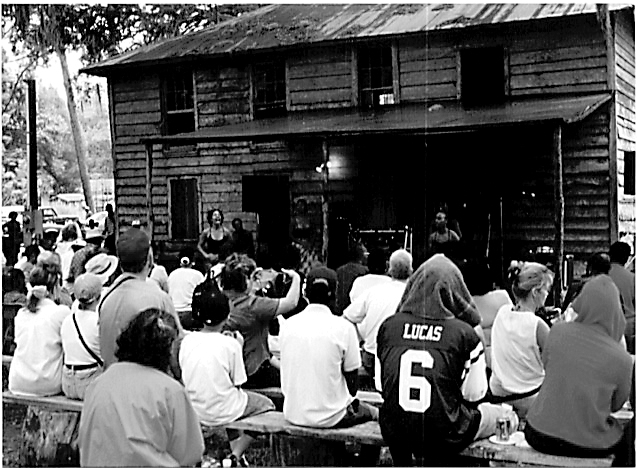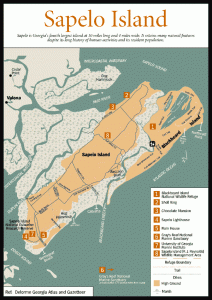
Do you know about the Gullah? Do you know about the Geechee people in Georgia? Not the popular 90s Nick Jr. T.V. show “Gullah Gullah Island,” featuring a spotted yellow tadpole named Binya Binya and his native family of friends, but the real life descendants of Sapelo island, still living and preserving their culture off the coast of the Gullah-Geechee Cultural Heritage corridor.
Students will get a chance to help preserve and experience the remaining Gullah-Geechee culture this Friday, Oct. 18 on a a three day trip to to Sapelo Island, former docking area of the Binyas, the first enslaved African Americans to arrive in the U.S. during the early 1800s.
This year, the Sapelo Island Legacy and Culture team at Georgia State will be studying the history of Black American terminology through the Gullah-Geechee Heritage culture and language. The theme: Children & Family, Cultivating Our Tree of Life from the Roots to the Fruit, will focus on family, education and self-identity.
“We come with an intellectual purpose,” SILC team director, Dr. Mary Brown Zeigler, said. “We want to show them that Georgia State, a research university, respects their history and culture.”
Running from Wilberforce, N.C. to Jacksonville, Fl., the Gullah-Geechee corridor is home to over fifty original descendants of West African slaves brought through forced migration from Sierra Leone.
These historic communites, known as Geechee and Binya in their native tongue, are now in danger of becoming extinct to real-estate development and the possible passing away of the Binyas.
Binyas, or Sapelo natives born and raised on the Island, date their heritage back to during the time of segregation. After the closing of schools during the 60s and 70s, the Binyas began to move outside of the island, consequently losing some of their culture to the more diverse  mainland.
mainland.
Zeigler said the Binyahs began losing their property, language and sense of postitive self-identity.
“The linguistic identity is the key element,” she said. “Because when you can say who you are, you know who you are. That is the key to holding communities together.”
After a while, many young people and native Binyahs were forced to find schooling and work outside of the island, later generations returning as cumyahs, or those that marry into the culture.
And in the mainland, Geechee and Binyah students were taught not to talk in their native tongue because it was characterized as broken English, much like how people define Black American terminology today, without really knowing the history.
“Why is the way black people talk merely an unsuccessful attempt to produce American English? If the Sapelo island community culture is understood, then community language is better understood,” she said.
She added that most people don’t think the Gullah-Geechee language is a real language, but said that those are excuses made by the passing on of misinformation and lack of knowledge.
Current generations of the Gullah-Geechee heritage are trying to keep, recover and restore the Gullah-Geechee culture in Georgia, but Zeigler says some of it has been lost or is going away.
Now, threatened by high property taxes, lack of resources and foreign corporate monopolies, the Binyah culture is quietly disappearing.
“If there are not enough descendants of Binyah, like the cumyah, then those who come to the culture are probably not preserving it,” Zeigler said.
Even though the Binyahs are passing away, they are leaving their history to the cumyahs. But what happens if the Cumyah do not keep that physical and emotional attachment?
By studying their culture, the SILC team students will be helping restore the pride of the Gullah-Geechee community.
“If those who come are there to keep the culture alive and the community strong then they are there to keep pushing on,” Zeigler said.
On Friday, Oct. 18 through Sunday, Oct. 20, students, friends, faculty, and family will get a chance to experience the coastal Georgia Geechee communities, starting on Friday, when participants will stopover the Geechee Kunda in Riceboro with the Georgia Geechee Shouters.
On Saturday, it’s all day on Sapelo Island with the Cultural Day Festival and on Sunday, a morning at the Savannah River Walk before returning back to Atlanta.
This year’s program will build on last year’s theme titledChildren & Family: Tapping the Roots Within. SILC teammate and English major, Dionne Blasingame, who helped organize the memorable 2012 event by assisting with lodging and photo-recording, reflected on the theme:
“Life is a sacred journey that changes, grows, discovers, moves, stretches, transforms, and pauses. And it is through family and faith that we experience life fully and deeply. It is through knowledge and understanding that we clearly see the lasting and lingering effects of family members on our lives—from the wisdom of great aunts to the innocent wisdom of nieces and nephews.”
